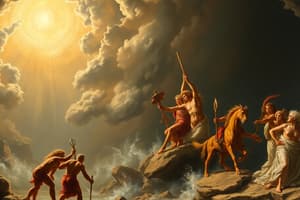Podcast
Questions and Answers
Que obras desenvolveu Hesíodo?
Que obras desenvolveu Hesíodo?
Hesíodo presenta un creador/demiurgo no seu modelo de creación.
Hesíodo presenta un creador/demiurgo no seu modelo de creación.
False
Que representa a evolución da humanidade segundo Hesíodo?
Que representa a evolución da humanidade segundo Hesíodo?
Unha evolución negativa.
O mito babilónico de ____ e Tiâmat corresponde á obra de Hesíodo.
O mito babilónico de ____ e Tiâmat corresponde á obra de Hesíodo.
Signup and view all the answers
Como comeza Ovidio a descrición da orixe do mundo?
Como comeza Ovidio a descrición da orixe do mundo?
Signup and view all the answers
Quen é rprogramma no mito das idades e das razas metálicas?
Quen é rprogramma no mito das idades e das razas metálicas?
Signup and view all the answers
Emparella os autores coas súas ideas correspondentes:
Emparella os autores coas súas ideas correspondentes:
Signup and view all the answers
Cal é a relación entre Ovidio e o mito de Prometeo?
Cal é a relación entre Ovidio e o mito de Prometeo?
Signup and view all the answers
Study Notes
Hesiod's Contributions
- Hesiod produced two major works: "Theogony" and "Works and Days," which serve as foundational texts for Greek cosmogony and ethics.
- Presents a dual evolution: the cosmos moves from disorder to order, while humanity's evolution is depicted as negative.
Creation According to Hesiod
- Offers one of the earliest Greek explanations for existence, diverging from the biblical Genesis.
- Emphasizes a procreative and genealogical model rather than a creator or demiurge.
- Describes a philosophical rather than mythical framework for creation.
Other Ancient Cosmogonies
- Various cosmogonies existed alongside Hesiod’s, such as:
- Apollodorus’ narrative begins with the union of Uranus and Gaia, omitting primordial Chaos.
- Greek myths suggest that deities and creatures emerged from the Ocean, with Tethys as their mother.
- The Babylonian myth of Apsû and Tiâmat parallels Hesiod's themes and may have influenced his narrative.
Orphic Myth and Ovid's Perspective
- The Orphic myth suggests the creation of the universe from an egg laid in darkness.
- Ovid's cosmogony departs from Hesiod by portraying a god organizing chaos rather than a creator god.
- Ovid describes an initial void devoid of space, time, or coherent relations, framing the origin of the universe in a negative context.
Elements in Ovid’s Cosmogony
- Describes original unity of water, earth, and air, but omits fire.
- Ovid posits chaos as a shapeless mass harboring unorganized seeds of elements.
- Uses poetic Greek terminology to invoke a sense of civilization transitioning from chaos.
Dichotomy of Control
- Ovid presents an ambiguity about the demiurge, likening divine power to a unifying force in contrast to Lucretius' notion of uncontrolled atomism.
- The cosmos under Ovid is characterized by universal governance, reflecting on imperial ideals of stability and order.
Hierarchical Creation of Life
- Ovid establishes a hierarchy among living beings: fish in water, beasts on land, and birds in the sky, placing humans at the apex.
- Humans stand in an intermediary category between animals and gods, distinguished by bipedalism and contemplative nature.
The Prometheus Myth
- Ovid revisits the Prometheus myth, incorporating divine seeds in the creation of humans, paralleling themes in Genesis.
- Hesiod extensively covers Prometheus's story concerning Zeus’ justice and humanity’s decline, without explicitly depicting him as a creator of figures.
Myth of Ages and Races
- Hesiod’s myth of ages describes humanity’s decline through four ages symbolized by metals: gold, silver, bronze, and iron, emphasizing justice and humility.
- Ovid tweaks this framework by removing the heroic age and altering the depiction of the gold age, influenced by predecessors like Aratus and Virgil.
Virgil's Influence
- Virgil simplifies Hesiod’s timeline to two ages and propounds a return to the Golden Age, linking it to Augustus as a savior figure.
- Associates the return of justice with the re-establishment of the Golden Age, symbolized by a newborn.
Impact and Legacy
- The concept of a Golden Age has been utilized politically in ancient Rome and during the Middle Ages, amidst claims of returning to better times.
- Ovid, like Virgil, introduces justice into his narrative, subtly challenging the Augustan narrative of a restored Golden Age through references to commercialism.
Studying That Suits You
Use AI to generate personalized quizzes and flashcards to suit your learning preferences.
Related Documents
Description
Este cuestionario explora as obras de Hesíodo, 'Teogonía' e 'Traballos e días'. A través de dúas narrativas opostas, analizamos a evolución do cosmos e da humanidade segundo Hesíodo. Descubre como ambos textos reflicten diferentes perspectivas sobre a orde e o desorde no mundo.




